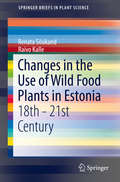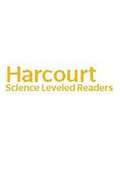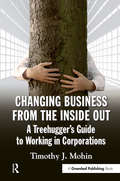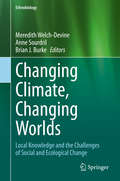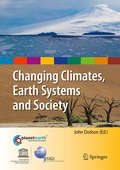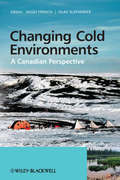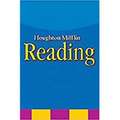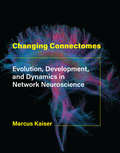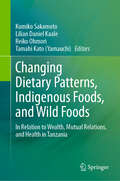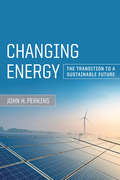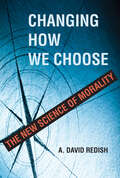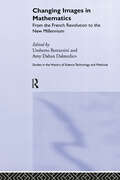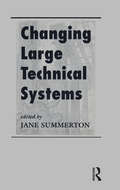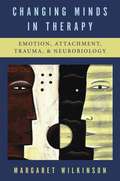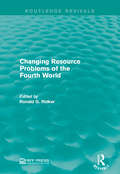- Table View
- List View
Changes in the Use of Wild Food Plants in Estonia: 18th - 21st Century (SpringerBriefs in Plant Science)
by Renata Sõukand Raivo KalleThis book is a systematized overview of wild edible plants eaten in the territory of present Estonia, with a focus on the systematic changes within the field. Starting in the end of 18th century, when the first data was published, the text is an extended version and compilation of articles on the subject published by Drs. Kalle and S#65533;ukand and includes unpublished fieldwork results. This work covers changes and tendencies not covered previously due to the limits of article length. Included in this data is a general overview table containing all used plant taxa, parts used and purposes of use. More details on specific food-uses are provided in separate chapters analysing dynamics of changes of the importance of wild plants within the specific food category.
Changes to Earth's Surface [Grade 5]: Below Level Reader (Science Leveled Readers Ser.)
by Houghton Mifflin Harcourt StaffNIMAC-sourced textbook
Changes: Science (Level Five)
by Purposeful DesignProviding excellence in science instruction for Christian schools worldwide, this text encourages curiosity while helping develop skills of scientific inquiry, challenging projects, diagramming, and focused assignments.
Changing Business from the Inside Out: A Treehugger’s Guide to Working in Corporations (Berrett-koehler Ser.)
by Timothy MohinCorporate responsibility is considered an oxymoron by much of society. Corporations are among the least trusted of our institutions; and the 2008 financial crisis, BP's oil spill in the Gulf of Mexico, and the collapse of the house of cards that was Enron have only added to public skepticism.So, at a time when trust in corporations has reached an all-time low, why is interest in corporate responsibility at an all-time high? A plausible explanation is that increasing numbers of stakeholders are demanding responsibility from corporations. Hyper-transparency of corporate activities, fueled by disclosure laws and the Internet, has increased awareness to the point where corporate behavior is under constant scrutiny. Smart business leaders are aware of this scrutiny and of the high costs of a public scandal. They know that in the long run it is cheaper to act responsibly now than to dig out from a PR disaster later.Tim Mohin is a veteran corporate responsibility practitioner who has led programs at Apple, Intel, and AMD. In this book, Tim tells us why he believes he is making a difference where it counts and how others can do the same. His book is a manual on how to steer the corporate supertanker toward doing good for people and our planet.Changing Business from the Inside Out provides a fascinating roadmap to the corporate responsibility and sustainability field, from beginning a career, to forming a program, to navigating the complicated politics of a corporation. Mohin likens the corporate treehugger role to "being the designated driver at the corporate cocktail party". Throughout his book, he argues strongly that activists can accomplish more for the planet and society by serving as a voice of responsibility within the corporation rather than protesting outside the factory gates. Corporations are clearly the drivers of the world economy, and the corporate responsibility practitioner has an essential role in bringing ethical and sustainable values to the C-suite and making sure that they are accomplished.Whether you are a practitioner needing advice, a mid-career professional wanting to change course, or an MBA wondering how to incorporate responsibility into your career, this book has the answers you need.
Changing Climate, Changing Worlds: Local Knowledge and the Challenges of Social and Ecological Change (Ethnobiology)
by Meredith Welch-Devine Anne Sourdril Brian J. BurkeThis book explores how individuals and communities perceive and understand climate change using their observations of change in the world around them. Because processes of climatic change operate at spatial and temporal scales that differ from those of everyday practice, the phenomenon can be difficult to understand. However, flora and fauna, which are important natural and cultural resources for human communities, do respond to the pressures of environmental change. Humans, in turn, observe and adapt to those responses, even when they may not understand their causes. Much of the discussion about human experiences of our changing climate centers on disasters and extreme events, but we argue that a focus on the everyday, on the microexperiences of change, has the advantage of revealing how people see, feel, and make sense of climate change in their own lives. The chapters of this book are drawn from Asia, Europe, Africa, and South and North America. They use ethnographic inquiry to understand local knowledge and perceptions of climate change and the social and ecological changes inextricably intertwined with it. Together, they illustrate the complex process of coming to know climate change, show some of the many ways that climate change and our responses to it inflict violence, and point to promising avenues for moving toward just and authentic collaborative responses.
Changing Climates, Earth Systems and Society (International Year of Planet Earth)
by John DodsonThe book covers state-of-the-art considerations on how climate change has and will deliver impacts on major globalised biophysical and societal themes that will affect the way the world functions. Human activity has resulted in changes to atmospheric chemistry and land cover, and caused serious decline in biodiversity. Modifying biogeochemical cycles leads to complex feedbacks. The future climate will have impact on food security and agriculture, water supply and quality, storm and cyclone frequency, shoreline stability, biodiversity and the future of biological resources. Earth scientists might be asked to forecast any potential abrupt or environmental surprises. A sound knowledge of the Earth System will improve the chances of achieving this, by developing climate models that will reduce the degree of uncertainty in regional climate prediction. . This volume sets out a framework of research issues that show how the Earth sciences contribute to a better understanding of climate change and suggests where future research will best contribute to the wellbeing of society. The key topics discussed are: - climate change patterns over the last four glacial cycles; - the variability in climate over the last 1000 years; - impact that past climate change has had on societies; - the role of human activities in climate forcing; - the role of models in predicting future climate and how we can assess their merit; - the future and likely future climate trajectories.
Changing Cold Environments
by Hugh M. French Olav SlaymakerChanging Cold Environments; Implications for Global Climate Change is a comprehensive overview of the changing nature of the physical attributes of Canada's cold environments and the implications of these changes to cold environments on a global scale. The book places particular emphasis on the broader environmental science and sustainability issues that are of increasing concern to all cold regions if present global climate trends continue. Clearly structured throughout, the book focuses on those elements of Canada's cold environments that will be most affected by global climate change - namely, the tundra, sub-arctic and boreal forest regions of northern Canada, and the high mid-latitude mountains of western Canada. Implications are considered for similar environments around the world resulting in a timely text suitable for second and third year undergraduates in the environmental or earth sciences courses.
Changing Colors (Houghton Mifflin Harcourt Vocabulary Readers #Leveled Reader: Level: 4, Theme: 3.1)
by Jesse David LynchIntroduces children to why and how leaves change colors during winter.
Changing Connectomes: Evolution, Development, and Dynamics in Network Neuroscience
by Marcus KaiserAn up-to-date overview of the field of connectomics, introducing concepts and mechanisms underlying brain network change at different stages.The human brain undergoes massive changes during its development, from early childhood and the teenage years to adulthood and old age. Across a wide range of species, from C. elegans and fruit flies to mice, monkeys, and humans, information about brain connectivity (connectomes) at different stages is now becoming available. New approaches in network neuroscience can be used to analyze the topological, spatial, and dynamical organization of such connectomes. In Changing Connectomes, Marcus Kaiser provides an up-to-date overview of the field of connectomics and introduces concepts and mechanisms underlying brain network changes during evolution and development.
Changing Dietary Patterns, Indigenous Foods, and Wild Foods: In Relation to Wealth, Mutual Relations, and Health in Tanzania
by Kumiko Sakamoto Lilian Daniel Kaale Reiko Ohmori Tamahi KatoThis book presents different dietary patterns, some utilizing wild foods and others facing drastically changing dietary patterns, and shows their implications for health in terms of wealth, mutual assistance, food sufficiency and food diversity. The book examines these globally important issues through a case study of Tanzania. Using a novel methodology based on a global standard quality of life indicator, the book sheds light on the relationship between wild food intake and health in Tanzania. Descriptive case studies illustrate the impact of various food patterns and wild food intake on human health. It also highlights the divergence between food production sufficiency and food diversity. It then discusses the influence of wealth, mutual relations, and methods of food access. Finally, the book concludes with recommendations for maintaining good health in various environments. The intended readers of this book are academics and professionals in the fields of development, nutrition, and environment in East Africa. These include, but are not limited to, regional and district personnel who are actively engaged in development, relevant ministries of food and agriculture, and international organizations such as FAO, UNICEF, UNDP, and UNEP. In the academic field, students and researchers in international studies, development studies, African studies, social studies, cultural studies, nutrition, agriculture, and environmental studies are targeted.
Changing Earth
by Barbara M. LindePerform this script about a Paiute Indian leader, writer, and teacher who tried to make life better for her people. (Set of 12 with Teacher's Guide)
Changing Earth
by Barbara M. LindePerform this script about a Paiute Indian leader, writer, and teacher who tried to make life better for her people. (Set of 12 with Teacher's Guide)
Changing Earth
by Barbara M. LindePerform this script about a Paiute Indian leader, writer, and teacher who tried to make life better for her people. (Set of 12 with Teacher's Guide)
Changing Earth
by Janette SchusterNIMAC-sourced textbook <p><p> Changing Earth introduces students to the earth science concept of how the distinct features of Earth came to be.
Changing Energy: The Transition to a Sustainable Future
by John H. PerkinsChanging Energy outlines how humanity established the current energy economy through three previous transitions, and how we now stand poised for a necessary fourth transition. Human societies around the globe have received immense benefits from uses of coal, oil, gas, and uranium sources, yet we must now rebuild our energy economies to rely on renewable sources and use them efficiently. The imperative for a fourth energy transition comes from dangers related to climate change, geopolitical tensions, documented health and environmental effects, and long-term depletion of today’s sources. John H. Perkins argues that a future in which current levels of energy service benefits are sustained can come only from investments in the technologies needed to bring about a fourth energy transition. Changing Energy envisions a viable post–fossil fuel economy and identifies the barriers to be overcome.
Changing Habitats
by Smithsonian InstitutionChanging Habitats is part of the Smithsonian Science Stories™ Literacy Series and has on-grade and below-grade leveled readers available to accommodate a range of readers in an elementary classroom. The line and dot graphic at the bottom of the front cover indicates the reading level. When the dot is at the top of the line, the reading level for the book is on-grade. When it is at the bottom, the book is below-grade. You can also find the official Lexile Scores for each reading in the Table of Contents. The books in this literacy series enhance and reinforce the science concepts taught in the Smithsonian Science for the Classroom™ curriculum units.
Changing How We Choose: The New Science of Morality
by A. David RedishThe &“new science of morality&” that will change how we see each other, how we build our communities, and how we live our lives.In Changing How We Choose, David Redish makes a bold claim: Science has &“cracked&” the problem of morality. Redish argues that moral questions have a scientific basis and that morality is best viewed as a technology—a set of social and institutional forces that create communities and drive cooperation. This means that some moral structures really are better than others and that the moral technologies we use have real consequences on whether we make our societies better or worse places for the people living within them. Drawing on this new scientific definition of morality and real-world applications, Changing How We Choose is an engaging read with major implications for how we see each other, how we build our communities, and how we live our lives.Many people think of human interactions in terms of conflicts between individual freedom and group cooperation, where it is better for the group if everyone cooperates but better for the individual to cheat. Redish shows that moral codes are technologies that change the game so that cooperating is good for the community and for the individual. Redish, an authority on neuroeconomics and decision-making, points out that the key to moral codes is how they interact with the human decision-making process. Drawing on new insights from behavioral economics, sociology, and neuroscience, he shows that there really is a &“new science of morality&” and that this new science has implications—not only for how we understand ourselves but also for how we should construct those new moral technologies.
Changing Images in Mathematics: From the French Revolution to the New Millennium (Routledge Studies in the History of Science, Technology and Medicine #13)
by Umberto Bottazzini Amy Dahan DalmedicoThis book focuses on some of the major developments in the history of contemporary (19th and 20th century) mathematics as seen in the broader context of the development of science and culture. Avoiding technicalities, it displays the breadth of contrasting images of mathematics favoured by different countries, schools and historical movements, showing how the conception and practice of mathematics changed over time depending on the cultural and national context. Thus it provides an original perspective for embracing the richness and variety inherent in the development of mathematics. Attention is paid to the interaction of mathematics with themes whose proper treatment have been neglected by the traditional historiography of the discipline, such as the relationship between mathematics, statistics and medicine.
Changing Large Technical Systems
by Jane SummertonThis international anthology presents case studies of historical and contemporary transformations of large technical systems such as railways, telecommunications, electricity, and automobiles. The authors, working at the forefront of historical and social science research on the dynamics of large technical systems, analyze how and why these systems undergo change. Because of their important roles in contemporary society, large technical systems such as railways, airlines, road systems, telecommunications, and electric power network share drawing considerable academic and political interest. In this collaborative study on processes of change in large technical systems, the contributing authors present historical and current case studies of transformation within these systems. Working at the forefront of historical and social science research on the dynamics of large technical systems, the authors specifically analyze how and why the systems undergo change. In some cases, new technologies are solving old problems and presenting opportunities for system growth. In other areas, new regulatory approaches have brought competition and deregulation, often posing challenges to system builders. The authors also show how the breakup of national boundaries and new corporate strategies for global management of technology are transforming systems in ways that will have significant impacts on all consumers
Changing Minds in Therapy: Emotion, Attachment, Trauma, and Neurobiology (Norton Series on Interpersonal Neurobiology)
by Margaret WilkinsonAddresses the flurry of questions about the practical application of neuroscience in clinical treatment. Recent advances in research in the fields of attachment, trauma, and the neurobiology of emotion have shown that mind, brain, and body are inextricably linked. This new research has revolutionized our understanding of the process of change in psychotherapy and in life, and raised a flurry of questions about the practical application of neuroscience in clinical treatment, particularly with those who have experienced early relational trauma and neglect. What insight does neuroscience offer to our clinical understanding of early life experiences? Can we use the plasticity of the brain to aid in therapeutic change? If so, how? Changing Minds in Therapy explores the dynamics of brain-mind change, translating insights from these new fields of study into practical tips for therapists to use in the consulting room. Drawing from a wide range of clinical approaches and deftly integrating the scholarly with the practical, Margaret Wilkinson presents contemporary neuroscience, as well as attachment and trauma theories, in an accessible way, illuminating the many ways in which cutting edge research may inform clinical practice.
Changing Patterns in Israel Agriculture (Routledge Library Editions: Agriculture #6)
by Haim HalperinFirst published in 1957. This study sought to analyse the problems raised by the changing forces and conditions in Israel in the middle of the twentieth-century. It discusses the impact of Israel’s achievement of political sovereignty upon its agricultural economy in the comparatively short space of six years. It examines the agricultural problems that arose as functions of the natural factors of production – land, water, climate, etc. It endeavoured to assess new and better possibilities of farming. This title will be of interest to students of geography and agriculture.
Changing Resource Problems of the Fourth World (Routledge Revivals)
by Ronald G. RidkerClimbing food, fertiliser and mineral prices as well as the Arab oil embargo in the seventies had severe economic consequences in developing countries. Originally published in 1976, this study explores the effects of these developments in the fourth world and how they can adjust to an international economy with a particular focus on resource availability in terms of energy and agriculture. This title will be of interest to students of Environmental Studies.
